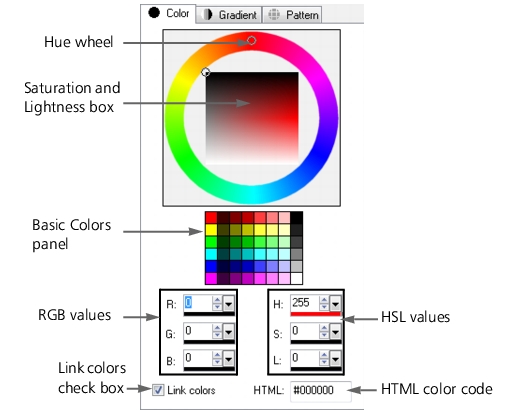Choosing colors by using the Color Picker
When you edit images in Corel PaintShop Pro, you often need to choose a color before painting, drawing, or filling, making manual color corrections, or choosing a background for a new raster image. The Color Picker is the most versatile tool for choosing colors.
The Color Picker appears when you click the Foreground/Stroke Properties box, the Background/Fill Properties box, or one of the two smaller Color boxes. It also appears when you click a Color box found in other dialog boxes.

The Color Picker
The appearance of the Color Picker depends on the color depth of the active image (16 bits/channel, 8 bits/channel, 256 colors, 16 colors, or 2 colors).
The Color Picker offers many ways to select colors:
• |
The Color (hue) wheel and Saturation and Lightness box let you
select and preview a color.
|
• |
The Basic Colors panel displays commonly used colors.
|
• |
RGB or HSL values let you choose a color based on its red, green,
and blue values or its hue, saturation, and lightness values.
|
• |
HTML color code lets you enter HTML color values.
|
• |
The Color Picker lets you select a color from the active image.
|
By default, Corel PaintShop Pro displays decimal (base 10) numbers in the Color Picker. You can also display hexadecimal (base 16) numbers — the format of HTML color codes. For more information about display and caching options, see Setting Display and Caching preferences. For more information about color and how it is perceived, displayed, and printed, see Understanding color and color models.
| To choose a color by using the Color Picker |
Edit workspace
1 |
On the Materials palette, do one of the following:
|
• |
To choose a foreground color, click the Foreground and Stroke
Properties box or the Foreground Color box.
|
• |
To choose a background color, click the Background and Fill
Properties box or the Background Color box.
|
The Material Properties dialog box or the Color dialog box appears. |
If the Materials Property dialog box appears, click the Color tab. |
2 |
Click or drag the hue wheel to select the approximate color.
|
3 |
Click or drag inside the Saturation/Lightness box to set saturation
and lightness for the color you have selected.
|
Move from left to right to adjust the saturation; move from top to bottom to adjust the lightness. |
You can also choose a color directly on the Frames tab or the
Rainbow tab of the Materials palette. The Frames tab contains
a more compact, rectangular version of the color wheel and its
controls. The Rainbow tab presents every available color. Click
to choose the foreground color, or right-click to choose the
background color.
|
You can access recently used colors by right-clicking the Color
box on the Materials palette. In the Recent Colors dialog box,
click Other to display the Material Properties dialog box.
|
To use the current colors with all tools, mark the All tools check
box on the Materials palette. If you unmark this check box, the
current materials are used by the active tool only.
|